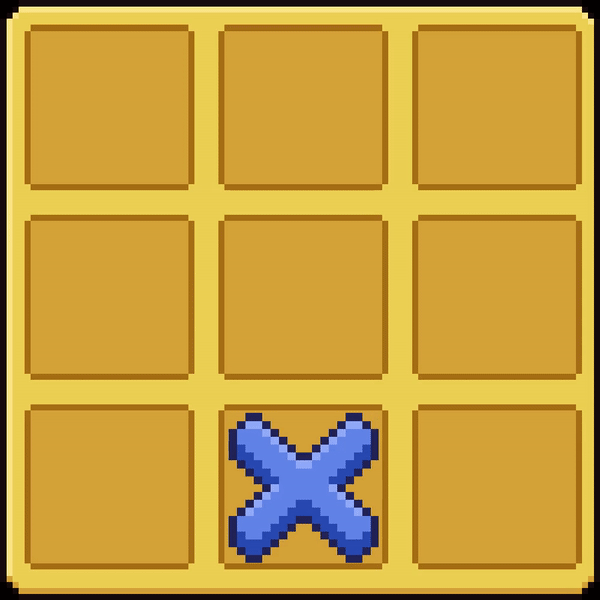Tic Tac Toe¶

This environment is part of the classic environments. Please read that page first for general information.
Import |
|
|---|---|
Actions |
Discrete |
Parallel API |
Yes |
Manual Control |
No |
Agents |
|
Agents |
2 |
Action Shape |
(1) |
Action Values |
[0, 8] |
Observation Shape |
(3, 3, 2) |
Observation Values |
[0,1] |
Tic-tac-toe is a simple turn based strategy game where 2 players, X and O, take turns marking spaces on a 3 x 3 grid. The first player to place 3 of their marks in a horizontal, vertical, or diagonal line is the winner.
Observation Space¶
The observation is a dictionary which contains an 'observation' element which is the usual RL observation described below, and an 'action_mask' which holds the legal moves, described in the Legal Actions Mask section.
The main observation is 2 planes of the 3x3 board. For player_1, the first plane represents the placement of Xs, and the second plane shows the placement of Os. The possible values for each cell are 0 or 1; in the first plane, 1 indicates that an X has been placed in that cell, and 0 indicates that X is not in that cell. Similarly, in the second plane, 1 indicates that an O has been placed in that cell, while 0 indicates that an O has not been placed. For player_2, the observation is the same, but Xs and Os swap positions, so Os are encoded in plane 1 and Xs in plane 2. This allows for self-play.
Legal Actions Mask¶
The legal moves available to the current agent are found in the action_mask element of the dictionary observation. The action_mask is a binary vector where each index of the vector represents whether the action is legal or not. The action_mask will be all zeros for any agent except the one
whose turn it is. Taking an illegal move ends the game with a reward of -1 for the illegally moving agent and a reward of 0 for all other agents.
Action Space¶
Each action from 0 to 8 represents placing either an X or O in the corresponding cell. The cells are indexed as follows:
0 | 3 | 6
_________
1 | 4 | 7
_________
2 | 5 | 8
Rewards¶
Winner |
Loser |
|---|---|
+1 |
-1 |
If the game ends in a draw, both players will receive a reward of 0.
Version History¶
v3: Fixed bug in arbitrary calls to observe() (1.8.0)
v2: Legal action mask in observation replaced illegal move list in infos (1.5.0)
v1: Bumped version of all environments due to adoption of new agent iteration scheme where all agents are iterated over after they are done (1.4.0)
v0: Initial versions release (1.0.0)
Usage¶
AEC¶
from pettingzoo.classic import tictactoe_v3
env = tictactoe_v3.env(render_mode="human")
env.reset(seed=42)
for agent in env.agent_iter():
observation, reward, termination, truncation, info = env.last()
if termination or truncation:
action = None
else:
mask = observation["action_mask"]
# this is where you would insert your policy
action = env.action_space(agent).sample(mask)
env.step(action)
env.close()
API¶
- class pettingzoo.classic.tictactoe.tictactoe.raw_env(render_mode: str | None = None, screen_height: int | None = 1000)[source]¶
- action_space(agent)[source]¶
Takes in agent and returns the action space for that agent.
MUST return the same value for the same agent name
Default implementation is to return the action_spaces dict
- close()[source]¶
Closes any resources that should be released.
Closes the rendering window, subprocesses, network connections, or any other resources that should be released.
- observation_space(agent)[source]¶
Takes in agent and returns the observation space for that agent.
MUST return the same value for the same agent name
Default implementation is to return the observation_spaces dict
- observe(agent)[source]¶
Returns the observation an agent currently can make.
last() calls this function.
- render()[source]¶
Renders the environment as specified by self.render_mode.
Render mode can be human to display a window. Other render modes in the default environments are ‘rgb_array’ which returns a numpy array and is supported by all environments outside of classic, and ‘ansi’ which returns the strings printed (specific to classic environments).


